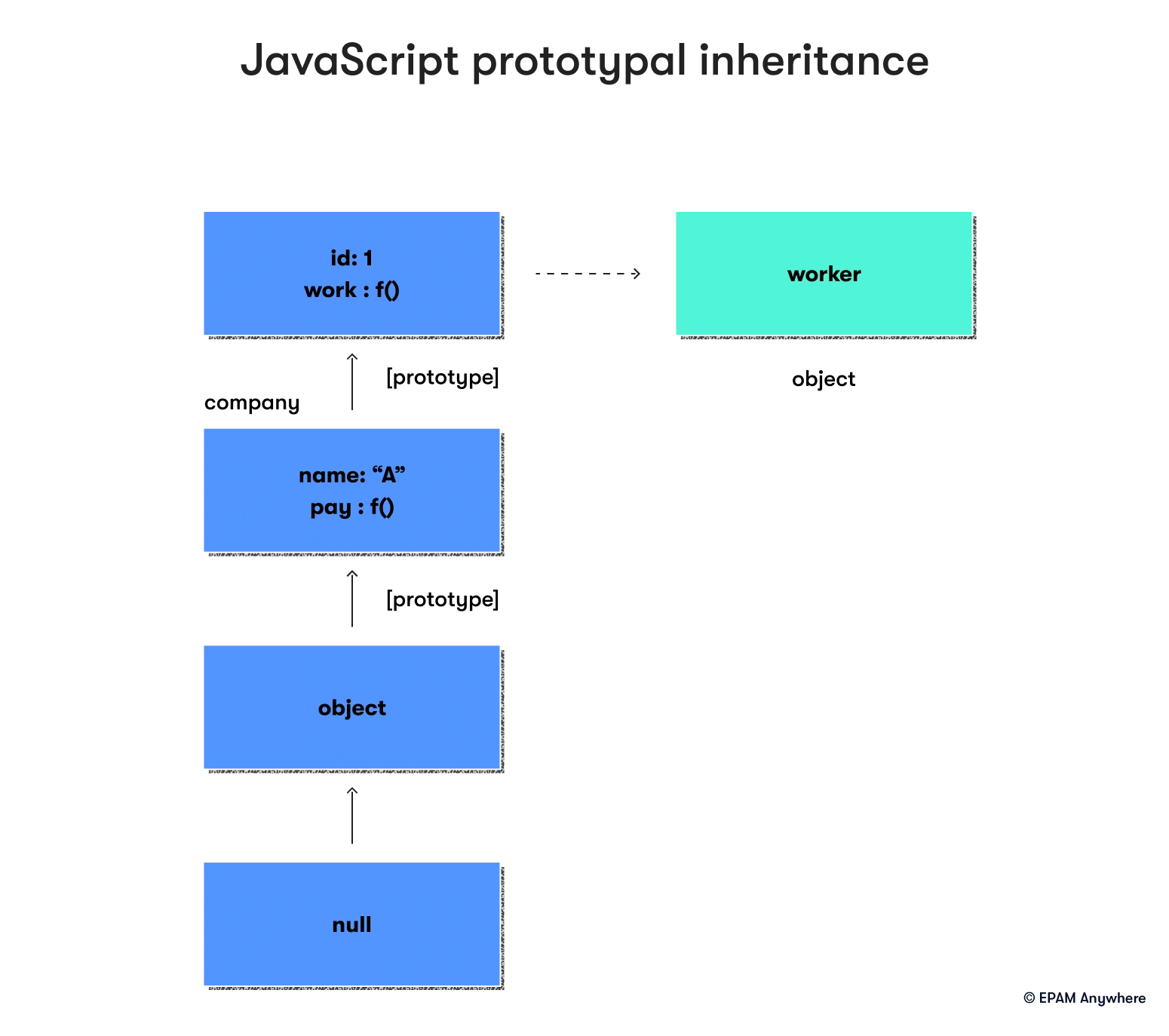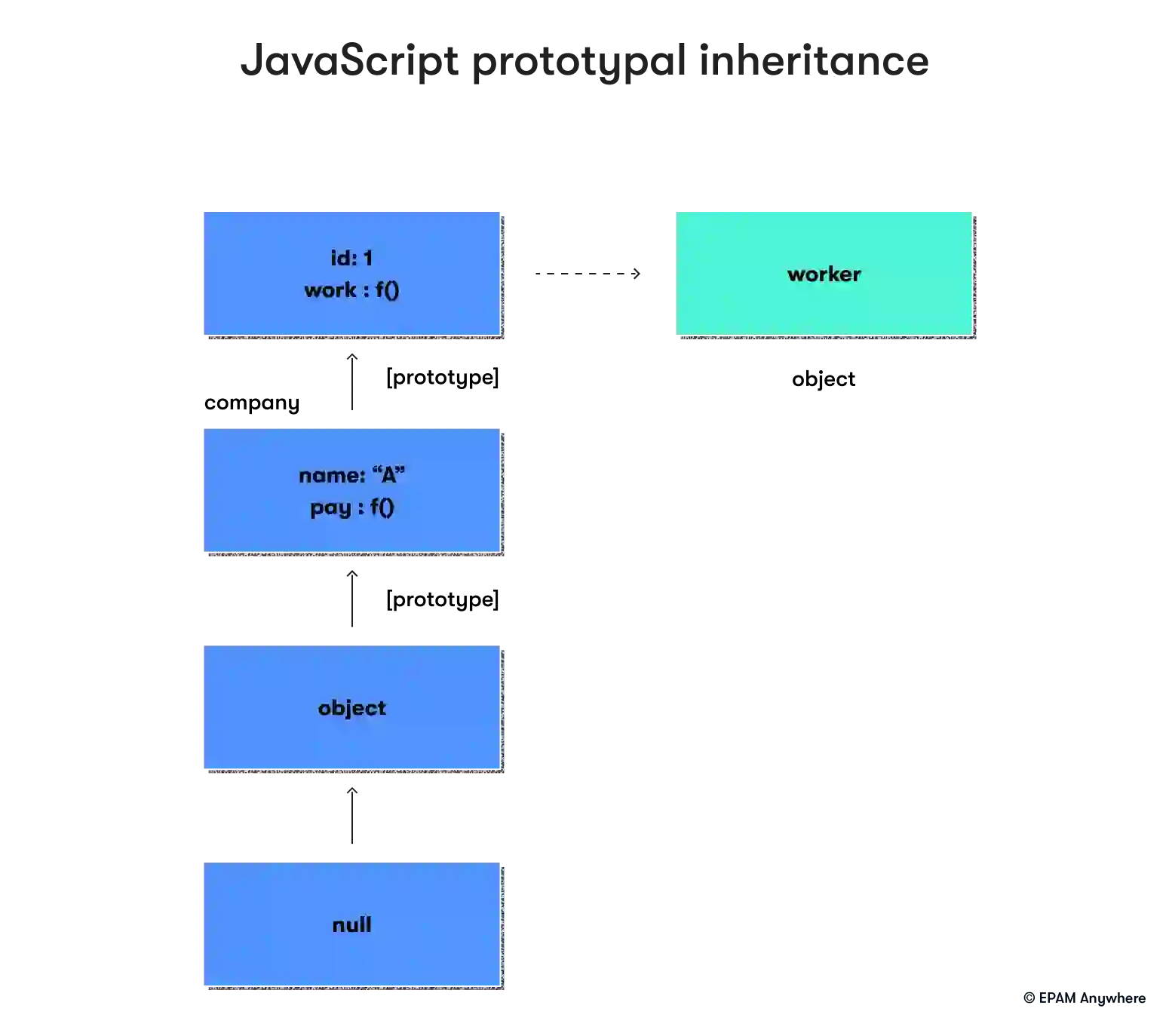These interview questions and answers have been reviewed and verified by Jury Salaviej, Lead Software Engineer at EPAM. Thanks a lot, Jury!
If you’re a seasoned JavaScript developer preparing for your next interview, having a set of insightful questions at hand is crucial. Our comprehensive list of senior JavaScript developer interview questions covers various topics, from fundamental JavaScript concepts to advanced programming techniques.
These JavaScript senior interview questions are designed to assess a candidate's depth of knowledge, problem-solving abilities, and understanding of best practices in JavaScript development. Read on to explore these questions and enhance your preparation for the interview process.
ready for your next interview?
Send us your CV and we'll get back with a senior JavaScript developer position to match you
1. Can you explain how JavaScript handles asynchronous operations?
JavaScript is a programming language capable of handling asynchronous operations efficiently. There are various methods through which JavaScript handles asynchronous operations such as callbacks, promises, and async/await.
Callbacks are an essential part of asynchronous programming in JavaScript. They are passed as arguments to other functions and are invoked after the completion of some operation. Callbacks are used to ensure that a function is not executed until a necessary operation is complete.
Promises are another method for handling asynchronous operations in JavaScript. Promises are used to handle asynchronous operations that may take some time to complete, such as fetching data from an API or reading data from a file.
Async/await is a newer syntactic sugar introduced in ECMAScript 2017 that simplifies the process of writing asynchronous code in JavaScript. It is built on top of promises and provides a more concise and readable syntax for handling asynchronous operations. Async/await lets engineers write asynchronous code that looks and behaves like synchronous code, making it easier to understand and maintain.
In summary, JavaScript provides various methods for handling asynchronous operations, including callbacks, promises, and async/await. Each method has its own advantages and disadvantages, and developers can choose the method suitable for their needs to write efficient and effective asynchronous code.
2. What is the difference between "==" and "===" in JavaScript?
In JavaScript, there are two types of equality operators: "==" and "===". The "==" operator performs type coercion before comparing, which means it converts the operands to the same type if they are of different types. For instance, if you compare a string with a number using "==", JavaScript will try to convert the string to a number before comparing them. However, this can lead to unexpected results, especially when dealing with complex data types.
On the other hand, "===" is a strict equality operator that does not perform type coercion. If the operands are of different types, it returns false without trying to convert them. This makes it a safer and more reliable option for comparing values in JavaScript, as it ensures that the comparison is based on the actual values of the operands, rather than their types or coerced values.
3. Can you explain closures in JavaScript?
In JavaScript, a closure is a function that has the ability to access its own scope, as well as the scopes of the functions that surround it and the global scope. This feature allows functions to remember and access variables from an outer function even after the outer function has been executed.
The outer function's variables and parameters are then accessible within the inner function, even after the outer function has finished running.
This is a powerful tool in JavaScript programming, as it allows developers to create functions that can retain information and operate with greater flexibility and efficiency. However, it's also important to be aware of potential memory leaks and unintended consequences that can arise from improper use of closures.
4. Explain the difference between null and undefined in JavaScript
In JavaScript, the term 'undefined' refers to a variable that has been declared but has not yet been assigned a value. When a variable is declared yet not initialized, it is automatically assigned the value of undefined by JavaScript. This is different from null, which is an assignment value used to represent the absence of any object or value. In other words, null is explicitly assigned by a programmer to indicate that a variable has no value. It is important to understand the difference between these two concepts in JavaScript, as they can have different implications for your code depending on how they are used.
5. How does JavaScript's event loop work?
In JavaScript, an event loop is a mechanism used for managing asynchronous operations and executing callbacks non-blocking. It is a single-threaded loop that continuously monitors the call stack and the callback queue.
The call stack is a data structure that tracks the execution of functions in JavaScript. Whenever a function is invoked, it is pushed onto the call stack. When the function completes its execution, it is popped off the stack.
On the other hand, the callback queue holds a list of functions ready to be realized once the call stack is empty. Whenever an asynchronous operation, such as an event listener or a network request, completes its execution, its associated callback function is pushed into the callback queue.
When the call stack is empty, the event loop takes the first function from the callback queue, pushing it to the call stack, which effectively runs it. This process continues indefinitely, with the event loop continuously monitoring both the call stack and the callback queue to ensure that JavaScript code is executed in a non-blocking and efficient way.
6. What is the difference among "let", "const", and "var" in JavaScript
"var" is a function scoped and can be redeclared and updated. "let" and "const" are block scoped. "let" can be updated but not redeclared, while "const" can neither be updated nor redeclared.
7. Can you explain how prototypal inheritance works in JavaScript?
JavaScript is an object-oriented programming language. In JavaScript, every object has a prototype object that acts as a template object that it inherits methods and properties from. An object's prototype object may also have a prototype object from which it inherits methods and properties, creating a chain of prototypes. This chain of prototypes is called the prototype chain. The prototype chain allows objects to inherit properties and methods from their ancestors, which can be useful for code reuse and efficiency. By using the prototype chain, you can avoid duplication of code and create more efficient and maintainable code.

8. What is the purpose of JavaScript's "this" keyword?
The "this" keyword is used to refer to the object that it belongs to. The value of "this" varies depending on the context in which it is used. For instance, when used inside a method, "this" refers to the object that the method is called on. When used alone, "this" refers to the global object. Similarly, when used inside a function, "this" also refers to the global object. On the other hand, when used inside an event, "this" refers to the element receiving the event. It is important to note that the value of "this" is determined at runtime and depends on the way in which the function or method is called.
9. Can you explain how hoisting works in JavaScript?
In JavaScript, hoisting is a mechanism that rearranges the order in which variables and function declarations are processed during the compilation phase. The process involves moving the declarations to the top of their containing scope, which makes them available for use before their actual placement in the code. It's important to note that only the declarations are hoisted, and not their initializations. This means that variables and functions can be referenced before they are declared, but any assignments or function expressions that include them must come after their declaration.
10. Describe the difference between a method and a function in JavaScript
The function is a block of code designed to perform a particular task. A function is executed when something invokes it (calls it).
A method, on the other hand, is a function of an object. Methods get defined the way normal functions are defined, but they have to be assigned as the property of an object. Methods are typically used to update an object's properties or perform operations based on an object's current properties.
11. Can you explain the concept of promises in JavaScript?
In JavaScript, a Promise is a special object representing an asynchronous operation's eventual completion or failure. It's like a placeholder for the outcome of the operation. Every Promise can be in one of three states: pending, fulfilled, and rejected.
When a Promise is pending, the asynchronous operation is not yet completed, and the final result is unknown. Once the operation completes successfully, the Promise transitions to the fulfilled state, and the final result is available. If the operation fails for an error or some other reason, the Promise transitions to the rejected state, and the reason for the failure is available.
Promises are incredibly useful in JavaScript because they let developers write cleaner and more efficient code for handling asynchronous operations. You can chain multiple asynchronous operations, handle errors gracefully, and simplify your code.
12. What is the difference between asynchronous and synchronous programming in JavaScript?
Synchronous programming, also known as blocking programming, is a programming model where the code is executed sequentially from top-to-bottom, meaning that the next operation is blocked until the current one completes. This means that the program's execution is halted until the current operation is completed, and only then can the next operation be executed. This approach can be useful for simple programs that require a linear execution flow, but it can become problematic when dealing with more complex programs.
On the other hand, asynchronous programming is a programming model where the engine runs in an event loop. When an operation blocking is needed, the request starts, and the code keeps running without blocking for the result. This means that the program can continue to execute while waiting for the result of the operation. When the response is ready, the interrupt is fired, causing an event handler to be run, where the control flow continues. This approach helps reach a more efficient use of resources and can be particularly useful when dealing with long-running operations or when working with network I/O. However, it also requires a more complex programming model and can be difficult to understand and debug.
13. Explain event delegation in JavaScript
Delegation of an event is the process where you delegate listening for events to a parent element. This allows you to listen for events that are fired on dynamically added elements or prevent the need for adding and removing event listeners when nodes are updated.
The principle behind event delegation is event bubbling. When an event occurs on a DOM element, that event is not entirely contained to that one element. After the event has been handled, it "bubbles" up to the element's parent, and the parent's parent, and so on, until it reaches the document object.
14. What is the purpose of the Array.map() function in JavaScript?
The Array.map() function is a built-in method in JavaScript that creates a new array by calling a function on each element in the original array and then storing the returned values in the new array. This method is typically used when you want to apply a transformation to all array elements in a consistent manner. For instance, you can convert all elements to uppercase, extract a specific property from each element, or perform a mathematical operation on each element.
It's important to understand that this process does not alter the original array. Instead, the function creates a new array with the transformed elements. This means that the map() function is a pure function, which means it does not modify the original array or has no side effects.
15. Can you explain the concept of functional programming and how it's applied in JavaScript?
Functional programming is a type of software engineering where programs are constructed with the application of functions. It avoids changing state and mutable data. In JavaScript, we can apply functional programming concepts using functions as first-class objects, higher-order functions, and pure functions.
16. Describe the difference between an arrow function and a regular function in JavaScript
Arrow functions and regular functions in JavaScript differ in several ways:
- Syntax: Arrow functions have a shorter syntax than regular functions. You can omit the `function` keyword, the `return` keyword (for single-line blocks), and the curly brackets (for single-line blocks).
- “this" keyword: In regular functions, the `this` keyword shows the object that is called the function, which could be the document, the window or whatever. However, the `this` keyword doesn't bind its value in arrow functions. It inherits it from the enclosing lexical context. This makes it easier to predict its behavior.
- Arguments object: Regular functions have their own `arguments` object. On the other hand, arrow functions do not have their own `arguments` object. Instead, you can use rest parameters to achieve similar functionality.
- Constructors: Regular functions created using the `function` declaration can be used as constructors (i.e., you can use the `new` keyword with them). Arrow functions, however, cannot be used as constructors. If you try to use the `new` keyword with an arrow function, it will show an error.
- Prototype property: Regular functions have a prototype property, but arrow functions do not have this property.
- Method definitions: If you're defining methods within an object literal, you'll typically want to use regular function syntax for the method definition, as it makes the `this` keyword behave as expected.
17. Can you explain the concept of destructuring in JavaScript?
Destructuring in JavaScript is a feature introduced in ES6 that allows you to unpack values from arrays, or properties from objects, into distinct variables. This can greatly simplify your code, making it more readable and maintainable.
For example, consider an array let arr = [1, 2, 3]. Without destructuring, if you wanted to assign these values to separate variables, you would have to do something like this:
With destructuring, you can achieve the same result in a single line of code:
The same can be done with objects. For example, consider an object let obj = {name: 'John', age: 30}. Without destructuring, to assign these values to separate variables, you would do:
With destructuring, you can do:
Destructuring can also be used in function parameters, making it easier to work with functions that return arrays or objects.
18. Describe the purpose of the spread operator in JavaScript
The spread operator in JavaScript is used to spread the elements of an array (or any iterable) into places where zero or more elements are expected, or to spread the properties of an object into a new object.
19. Explain memoization in JavaScript
Memoization is a type of optimization technique used in computer programming to enhance the speed of programs. It works by storing the results of expensive function calls and reusing them whenever the same inputs occur again. By doing so, the program avoids repeating the same calculations and saves time by retrieving the result from the cache. This technique is useful in situations where the program has to perform complex calculations or repeatedly execute the same function with the same inputs. By using memoization, the program can reduce the time and resources needed to execute the code, making it more efficient and faster.
20. Describe the difference between a static method and an instance method in JavaScript
A static method is a method that's bound to the class, not an instance of the class. It's called on the class itself, not on instances. On the other hand, an instance method is available on an instance of a class, not on the class itself.
21. Explain the concept of data binding in JavaScript
Data binding in JavaScript is data synchronization between the model and view. The model and view are linked to allow automatic data synchronization between the model and view.

22. What is the difference between a JavaScript expression and a statement?
In JavaScript, an expression is any valid set of literals, variables, operators, and expressions that evaluates to a single value. A statement, on the other hand, acts. It could, for example, declare a variable or make a function call.
23. Can you explain the concept of immutability in JavaScript?
Immutability in JavaScript means that it can't be changed once a value is created. This is particularly useful in functional programming and can help to avoid side effects and make your code more predictable.
24. Can you explain the concept of strict mode in JavaScript?
In JavaScript, a specialized mode called "strict mode" enforces a stricter set of rules and restrictions on the code. It can be considered a "safer" version of JavaScript that helps developers avoid common mistakes and improve code quality. When strict mode is enabled, several silent errors that normally go unnoticed in regular JavaScript are caught and turned into thrown errors, making debugging much easier.
Additionally, strict mode fixes certain coding mistakes that can hinder JavaScript engine optimizations, improving performance. Finally, strict mode prohibits certain syntax and behaviors likely to be deprecated or removed in future versions of ECMAScript, thus helping ensure that your code remains future-proof. The strict mode is useful for developers who want to write high-quality, optimized, and future-proof JavaScript code.
25. What is the purpose of the JavaScript's Set object?
The JavaScript Set object is a collection of unique values. Values in a Set can be iterated in insertion order, and can only be added once; subsequent attempts to add the same value are ignored.
Conclusion
In conclusion, these senior JavaScript developer interview questions comprehensively guide you in understanding and grasping advanced JavaScript skills.
If you're a seasoned JavaScript developer looking for new opportunities, consider joining EPAM Anywhere. As a senior JavaScript developer at EPAM Anywhere, you'll have the chance to work on exciting projects, collaborate with global teams, and enjoy the flexibility of remote work. Start your remote career journey with EPAM Anywhere today.

With a focus on remote lifestyle and career development, Gayane shares practical insight and career advice that informs and empowers tech talent to thrive in the world of remote work.
With a focus on remote lifestyle and career development, Gayane shares practical insight and career advice that informs and empowers tech talent to thrive in the world of remote work.
Explore our Editorial Policy to learn more about our standards for content creation.
read more



























